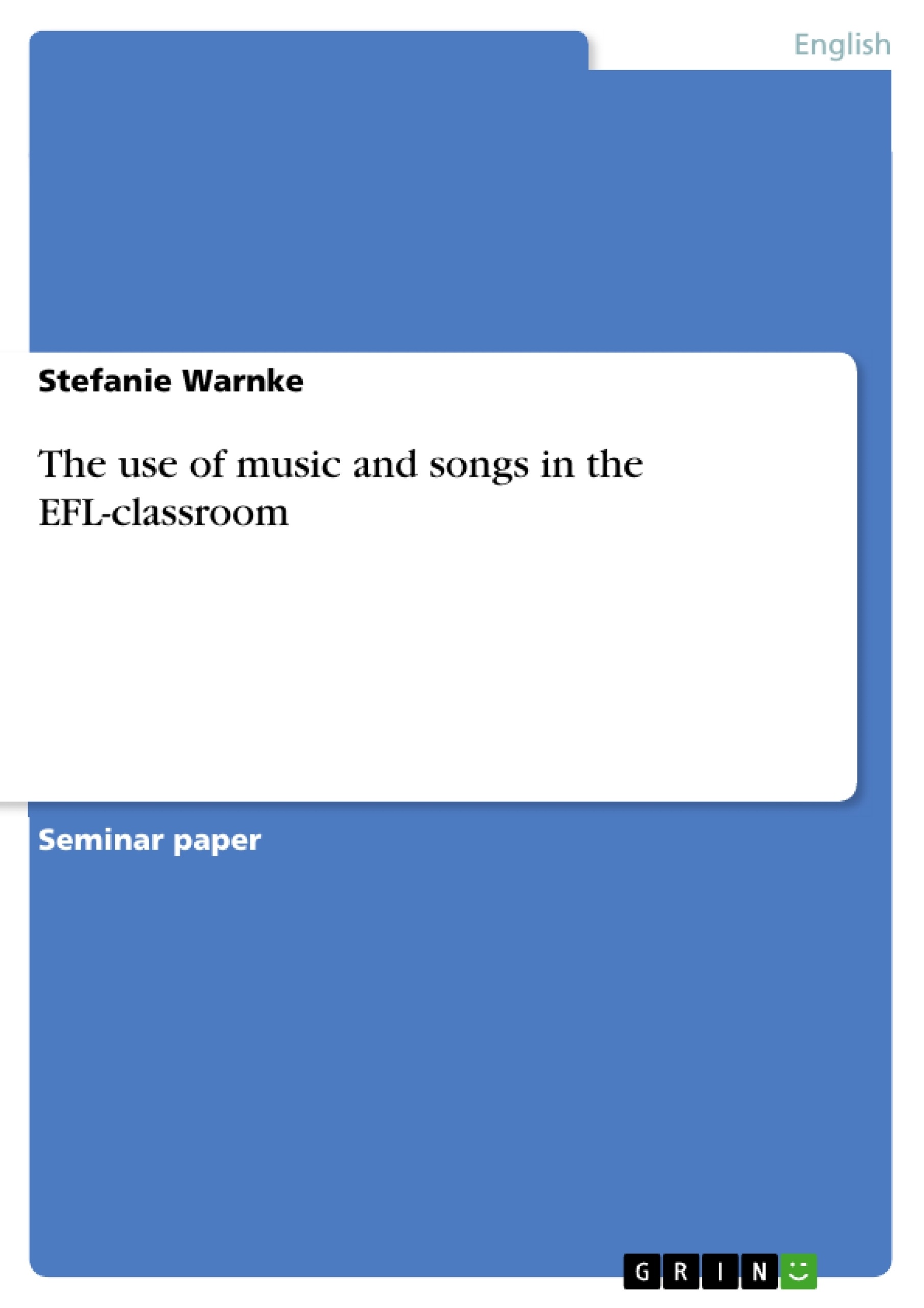I think that every teacher of a foreign language should provide various strategies of learning for the pupils. It is the teacher’s task to combine the different approaches of learning in order to make learning less complicated and more pleasant for the learn-ers. In my eyes, learning with songs and music, seems to be a successful method of learning English. Music plays an important role in the life of almost every person. We are surrounded by music all day long – while shopping in the super market, while eat-ing in a restaurant, even in the bathroom. Especially young people love music, but they do not only consider a song ‘cool’ when they like the artist, the melody or the sound of this piece of music. Nearly as important as that is the fact that the song conveys a particular message. In most cases, young people always identify them-selves with the content of the song, mainly when it touches a topic the pupil is very interested in or something the young person is about to go through (e.g. being love-sick or having problems with the social environment…). That means that young peo-ple have to concern with the lyrics of the song. This can be seen as a voluntary oc-cupation with language. And as long as this song is written in a language which is taught at school, every future teacher should catch this opportunity and make use of music and songs in the classroom. Music and songs provide quite a lot of material, which can be used for learners of English as a foreign language. There are quite a lot of positive sides of learning English via the medium music. First of all it is a very posi-tive way of learning English. Music is a part of our everyday life and especially young people are very familiar with music. If the teacher provides the possibility of a positive access to a new topic, the kids will learn the new things easier and with more fun and readiness. I am sure that the one or the other pupil turns out to be a little “music-expert”. This can strengthen the self-consciousness of students who are not so good at other areas because now they have the opportunity to show what they know about a special artist or band. Another pro of teaching language by using songs and music is that it is something different for the students – it is an alternation to the common methods of language learning, because it is not only interested in input. [...]
Inhaltsverzeichnis (Table of Contents)
- Introduction - Some general statements
- The importance of the right song selection
- My suggestions for a thematic sequence
- Phil Collins »Another day in Paradise«<, Ralph McTell »>Streets of London«
- Tracy Chapman »Fast Car<< and Elvis Presley >>In the Ghetto<<
- Cat Stevens »New York Times« and Bob Dylan »Like a rolling stone
- Other appropriate songs for the classroom
- My suggestions for a thematic sequence
- Exercises according to songs in the classroom
- Pre-listening activities
- While-listening activities
- Post-listening activities
- Summary
- Appendix
- Bibliography
Zielsetzung und Themenschwerpunkte (Objectives and Key Themes)
This paper explores the use of music and songs in the EFL classroom, examining the potential benefits and drawbacks of incorporating this method into language teaching. The primary objective is to demonstrate how music can be a valuable tool for enhancing vocabulary acquisition, listening comprehension, and overall engagement in the learning process.
- The importance of song selection in EFL teaching.
- Effective strategies for incorporating music and songs into classroom activities.
- The potential for music and songs to enhance language learning through various exercises.
- Challenges and considerations for teachers when utilizing music in the classroom.
- The potential for music and songs to create a more positive and engaging learning environment.
Zusammenfassung der Kapitel (Chapter Summaries)
The introduction of the paper lays out the fundamental argument for using music and songs in the EFL classroom. It emphasizes the relevance and appeal of music to young learners, highlighting its potential for enhancing language learning. The chapter examines the role of music in everyday life, particularly for young people, and explores the connection between music and language acquisition.
Chapter 2 focuses on the critical role of song selection in the EFL classroom. It emphasizes the need to choose songs that are appropriate for the students' level of English and considers the challenges of engaging contemporary learners with potentially outdated music. The chapter proposes a thematic sequence of songs for classroom use, including examples of classic and popular songs. The chapter concludes with a discussion of the importance of considering student preferences and ensuring a balanced approach to song selection that avoids imposing the teacher's personal taste.
Chapter 3 delves into specific exercises that can be implemented with songs in the EFL classroom. It outlines activities for pre-listening, while-listening, and post-listening, showcasing the diverse ways that songs can be utilized to enhance various aspects of language learning. The chapter emphasizes the practical application of song-based activities and provides a framework for teachers to develop engaging and effective exercises.
Schlüsselwörter (Keywords)
The main keywords and focus topics of this paper include EFL teaching, music and song selection, classroom activities, language acquisition, listening comprehension, vocabulary development, student engagement, and contemporary music.
- Quote paper
- Stefanie Warnke (Author), 2006, The use of music and songs in the EFL-classroom, Munich, GRIN Verlag, https://www.grin.com/document/122444




